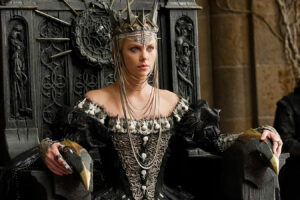FAIRYTALES have long woven magic with fabric. But this year’s Met Gala, the annual fundraiser for the Metropolitan Museum of Art’s Costume Institute in New York, took the connection between fantasy and fashion a step further.
Themed around the museum’s “Sleeping Beauties: Reawakening Fashion” exhibition, the dress code focused not on opulent displays of nature’s bounty but a more complex reality: the natural world and the essence of time. Inspired by J.G. Ballard’s short story, “The Garden of Time,” designers were invited to explore the intricate relationship between materials, their origins, and the fleeting nature of fashion trends.
The exhibition, which runs until September, provides an opportunity to reflect on the clash between artificial and natural materials in fashion. The reference to “sleeping beauties” suggests a useful context to consider how tangible, imperishable matter often sits alongside natural substances in fairytale worlds.
This tension played out on the Met Gala red carpet, where some attendees embodied the classic elegance of fairytale princesses and Prince Charmings, while others channeled more sinister characters.
Dress and materials play a transformative role in fairytales. Who can forget the significance of clothing (and those glass slippers) to Cinderella’s fate? An encounter with Prince Charming only becomes available to her when her torn rags are discarded in favor of a sparkling ballgown.
Scholar Maria Tatar suggests fairytales “favor the metallic”, while armor is a reminder of how materials generate associations with gender roles and social categories. In the 2012 film Snow White and the Huntsman, for example, costume designer Colleen Atwood envelops the wicked Queen Ravenna (played by Charlize Theron) in steel, gold and metalwork.
If luminous, unblemished surfaces initially attracted the prince in Cinderella, the wicked queen in this adaptation needs shimmering minerals and inorganic materials to remain desirable when threatened by the youthful Snow White.
Just like the function of armor on the battlefield, her garments seek an imperishable protection against ageing and mortality. It’s not surprising that such materials featured prominently in Met Gala responses to the theme of the passing of time.
The legacy of Atwood’s protective armor for the wicked queen was clear in John Galliano’s silver corset and skirt of mirrored segments worn by Kim Kardashian, in addition to the Stella McCartney chainmail hoodie she wore.
The seductive sheen of sparkling surfaces that worked so well for Cinderella permeated Jennifer Lopez’s Schiaparelli gown, and the decorated birdcage dress designed by Richard Quinn for actress Sarah Jessica Parker.
The costumes worn by Theron in Snow White and the Huntsman use manmade reflective surfaces to make a statement about the quest to challenge life’s fragility. When she can no longer control her ageing body, Atwood introduces more organic, perishable textures into her attire.
The natural lifecycle of living things provides a direct contrast to the solid, untarnished properties of the metallic. The seasonal deterioration of foliage and vegetation highlight changes in color and shape. The decaying process introduces aesthetically flawed surfaces and less tactile, smooth textures.
The contrast between material substances belonging to the “civilized” masculine world and the feminine spaces of the natural recall Sir Edward Burne-Jones’s painting The Briar Wood (1871–73). The artist depicts a scene from Sleeping Beauty when her potential suitors, clothed in armor, battle against the organic barrier of threatening thicket.
This connects with certain Met Gala costume ideas, presenting an alternative composition of nature to its visually appealing one.
DARK UNDERCURRENTSThe darker undercurrents of the organic were recognizable in the bronze, sinewy hawthorn branches that slithered up Sean McGirr’s Alexander McQueen dress, worn by singer Lana Del Rey.
Flesh-piercing thorny brambles adorned Jean Paul Gaultier’s design for presenter Emma Chamberlain. Connotations of strength and the refusal to be constrained were evoked in references to nature’s unnerving and hostile quality.
In fairytales, woods can be locations of anxiety that drive the storyline and characters. Such feral landscapes offer contrasting textures and surfaces that challenge the smooth shininess of manmade things.
These spaces are often the territories of outsiders. They embrace nature’s rough edges and offer an alternative identity to the glamor and glitz of the conventional.
Such style statements provide a welcome change to the designers and celebrities who played safe at the Met Gala, clad in healthy looking flowers and fauna. The elegance of Vogue editor Anna Wintour’s velvet Loewe coat, decorated in colorful tulips, was a case in point.
Observations in the press about the Met Gala have been predictably preoccupied with subjective descriptions of outfits as either flattering or ugly. But this year’s creative brief, drawn from literary sources, highlighted fashion’s capacity to move beyond restrictive classifications of attractive appeal.
Fashion has so much more to offer than merely dressing celebrities. The emphasis on materials, and the dialogue between textures and surfaces within a design, are an integral feature of all artistic practice.
Cath Davies is a senior lecturer Visual Culture, Cardiff Metropolitan University.






